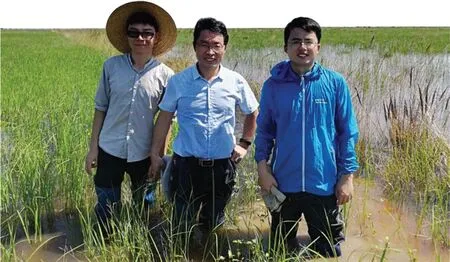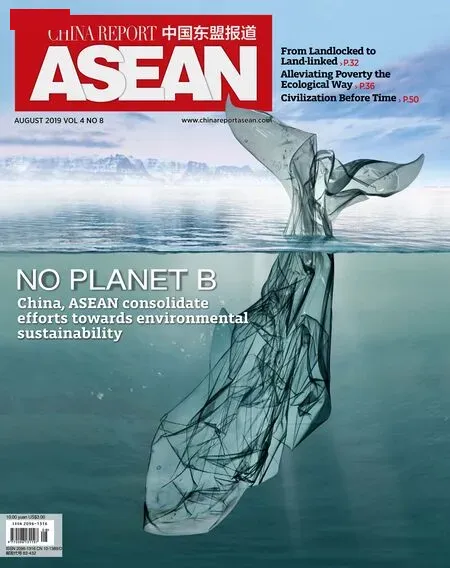CHINESE HIGH-TECH AG IN CAMBODIA New collaboration on harvesting rice and cotton
By Du Changwen
Northern Cambodia is home to Tonlé Sap Lake, the largest freshwater lake in Southeast Asia. Connecting the Tonlé Sap and Mekong rivers, this giant turquoise pool in the flat and broad plain of the Tonlé Sap basin measures 500 kilometers long and over 110 kilometers wide. The Tonlé Sap plain's bountiful sunshine, water and fertile land have made it the most important agricultural production base in Cambodia. The premium rice produced in the region has won the championship of the World Rice Conference many times and is renowned as White Gold.
However, the ideal natural environment and world-class rice species still do not guarantee a good harvest for local farmers working the 3 million hectares of paddy fields. Due to a shortage of advanced agricultural technologies and infrastructure, water and fertilizer resources are not fully utilized, restricting the average production of local fields to as low as less than 3 tons per hectare. It has become a pressing issue for Cambodia to increase the income of rural households and help them increase rice production.
Chinese Technologies Introduced to Cambodia

Technicians from the Institute of Soil Science under the Chinese Academy of Sciences at an experimental base in Cambodia.
In March 2016 at the first Lancang-Mekong Cooperation (LMC) Leaders' Meeting, Chinese Premier Li Keqiang gifted leaders of the five LMC countries Chinese hybrid rice. He declared that China's hybrid rice breeding would go global and help LMC countries become the world's granary. His remarks received an enthusiastic response from LMC leaders including Hun Sen, Prime Minister of Cambodia.
Jiangsu Lianfa Textile Co., Ltd. is a renowned manufacturer and the biggest dyed-yarn fabric producer in China. After assessing national needs and business development strategies in recent years, the company increased its investment in agriculture and affirmed a development strategy of integrating secondary and tertiary sectors with the primary sector. The consensus reached by Premier Li and the LMC leaders reassured the company that the environment would be conducive to conducting agricultural projects in Southeast Asia. In January 2018, Kong Xiangjun, chairman of the company' board of directors, visited the Institute of Soil Science under the Chinese Academy of Sciences three times and decided to cooperate with the institute on carrying out agricultural projects in Cambodia to help boost the country's agricultural production. They devised how to optimally harness the favorable conditions in light, temperature, water and heat in local fields by planting rice in rainy season and cotton in dry season.
During his visit to China in May 2018, Veng Sakhon, Minister of Agriculture, Forestry and Fisheries of Cambodia, praised the company's agricultural projects in Cambodia and affirmed that the Cambodian government supports the introduction of China's advanced agricultural technologies in a bid to benefit the local people. The Institute of Soil Science provided technical support for these projects. It studied and analyzed local conditions to determine the factors limiting production of rice and cotton, devised solutions and carried out tests to support strategies.
Thanks to the hard work of the staff at experimental bases in the Tonlé Sap basin, production of rice that season increased by 50 percent. Meanwhile, cotton planting finally became viable in Cambodia and filled the vacuum plaguing the country's agricultural production. In November 2018, Veng Sakhon met Kong and Du Changwen, a research fellow from the Institute of Soil Science. He complimented their work and encouraged them
China's technologies for soil testing and fertilizer recommendation, plant protection and field monitoring by drones were all put into operation.to expand application.

Planting rice in rainy season and cotton during dry season could effectively increase the income of local rural households in Cambodia.
Relentless Pursuit
Agricultural projects in Cambodia require great endeavors.
Cambodia's bounty of fertile land has given local farmers rich experiences in agricultural cultivation, and the country's land and labor are cheaper than in China. However, the promising prospects of Cambodian agriculture have been overshadowed by the country's shortage of agricultural infrastructure and a relatively weak economy. Unlike the Chinese government which has provided powerful support for agricultural projects, the Cambodian government has spared little for these projects. Development of the country's agriculture has been generally self-reliant.
Another factor is a relatively inefficient method of rice planting. In Cambodia, the soil becomes porous and loose after rainfalls in May and June, at which time farmers usually till their land with tractors or even cattle and then sow seeds directly into the soil. Fertilizer is rarely applied because only wealthier farmers have access to chemicals during the necessary times. The available pesticides are far from effective in preventing various plant diseases including rice blast, bacterial blight, stem borers and brown plant hopper. After sowing and fertilization if any, farmers spend little time tending the fields and plants until harvest season. The cultivation mode of Cambodia is distinct in three features: low input, low consumption and low production.
This mode cannot be applied to large-scale and modern agriculture. Therefore, Jiangsu Lianfa Textile Corporation planned to test and promote hybrid breeding of paddy rice, japonica rice and cotton. The targets for production of hybrid paddy rice, japonica rice and cotton in dry season were 6-8 tons per hectare, 4-5 tons per hectare and 4-5 tons per hectare respectively. In addition to selection and domestication of premium species of rice plants, modern technologies were introduced for all agricultural practices: China's technologies for soil testing and fertilizer recommendation, plant protection and field monitoring by drones were all put into operation. Meanwhile, the company projected investment of US$250 million to build large-scale industry-chain-wide infrastructure covering seed breeding, agricultural machinery, plant protection, fertilizer and pesticide formulation, crop storage and the processing of cotton and rice. Through integrating different sectors and applying a mode that connects farms and farmers, the company manages to provide complete services for farmers, aiming to upgrade Cambodia's agriculture to international standards and increase the income of local rural households.
The value of the work became even more apparent when the Chinese government decided to increase the quota of rice imports from Cambodia to 400,000 tons, lifting China past the European Union to become the biggest foreign market for Cambodian rice. The move will undoubtedly inspire even more win-win cooperation between China and Cambodia in agriculture, science and technology and other fields and facilitate common regional development and prosperity.
- China Report Asean的其它文章
- SEIZING SUSTAINABLE SOLUTIONS CHINA SETS THE STANDARD FOR ALLEVIATING POVERTY AND PROMOTING ONGOING GROWTH
- RIDING CHINA-ASEAN CULTURAL WAVES EMERGING OPPORTUNITIES FOR COOPERATION BETWEEN CHINA AND ASEAN IN CULTURAL AND CREATIVE INDUSTRIES
- PAGODA CITY Unforgettable memories in Bagan
- CIVILIZATION BEFORE TIME Archaeological Ruins of Liangzhu City named a UNESCO World Heritage Site
- RULES OF ATTRACTION Southeast Asian universities emerge as a new choice for Chinese students
- THE BOOK ON CULTURAL EXCHANGE A Chinese-Malaysian publishing MoU sets the stage for extensive cooperation

